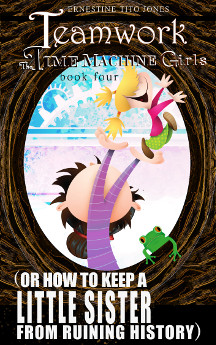What I love the best about writing The Time Machine Girls series is the history. Because history is such a huge subject, teachers can’t really go into detail about an event or a person when they teach it in class. So growing up, I only learned a couple things about Thomas Edison. I knew he was that old guy in a black-and-white photo who was famous for inventing the light bulb and the phonograph.
Done. End of story, move onto the next black-and-white photo and the next piece of history. But each person and each event has a story, and in Edison’s case, it was a much more interesting story than anything I ever learned sitting in my child-sized desk chair with my number-two pencil. There was a lot of “big business” that went behind that small invention known as the light bulb — there was also a bit of controversy too.
You see, the light bulb itself had already been invented. And many people do not consider Edison the inventor of the light bulb. However, the light bulb that was out wasn’t practical for home use. It was dangerous, way too bright for inside, burnt out quickly — and remember, we didn’t even have electricity flowing to our homes yet. This was all new stuff, and all part of the development. Because Edison was a famous American inventor who had successes in the field of electricity by improving the telegraph and inventing such things as the phonograph and the electric pen and press, investors loaned him a huge amount of money to create a practical light bulb. This wasn’t just out of the goodness of their hearts. They wanted to make money off the design and off the new industry of charging people for electricity flowing to their homes. To give you an idea of how big this was, one of the investors Edison was backed by was JP Morgan.
So Edison used the money to build Menlo Park, the first research and development laboratory. He hired assistants, mathematicians, physicists, a glass blower, a machinist… In other words, he wasn’t some old guy sitting around in his basement tinkering with a glass bulb and a filament until — Ta Da! — a light bulb went off in his head, and he designed the light bulb. Nope, he had help. He was consulting and testing, using systematic approaches and scientific methods and journals. He also wasn’t old. Edison was 32 when he perfected his light bulb design.
I was amazed by this guy, and I hope you will be too. I tried to be as accurate as I could. For book two Follow Failure, I used a book written by one of Edison’s assistants, Francis Jehl, called Menlo Park Reminiscences, which was an early account of the days he worked with Edison.
I was also amazed by how witty and charming Edison was — and by his perseverance! He had hundreds of failed attempts at the light bulb design, but he never gave up. That’s why I titled The Time Machine Girls book Follow Failure because I believe too many of us are perfectionists who give up in life after failures happen. Failure isn’t a bad thing. It should be expected and accepted as a very valuable learning tool in life. A much better one than success, as Bill Gates once said: “Success is a lousy teacher. It seduces smart people into thinking they can’t lose.”
Anyway, I could go on and on and on about all the amazing things I learned while researching this book. It was one of my favorites. I hope you like it too.
Photo Credit: “Thomas Edison2” by Louis Bachrach, Bachrach Studios, restored by Michel Vuijlsteke – This image is available from the United States Library of Congress’s Prints and Photographs division




